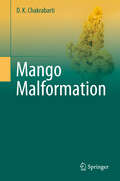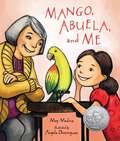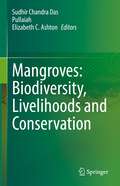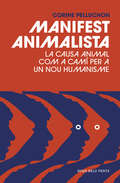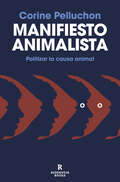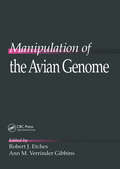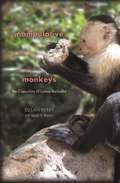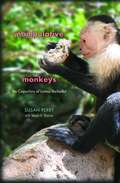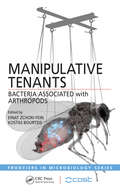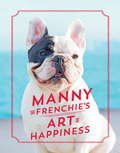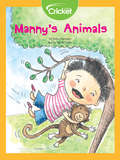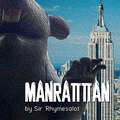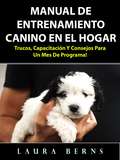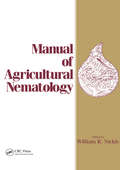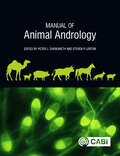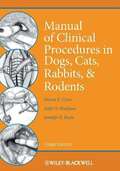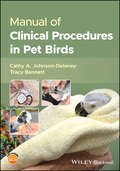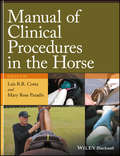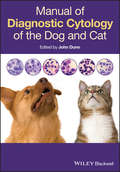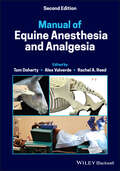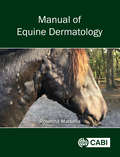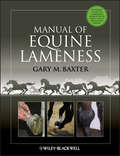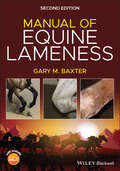- Table View
- List View
Mango Malformation
by D. K. ChakrabartiMalformation disease of mango (Mangifera indica) initially noted in patches in India has now turned into a global menace wherever mango is grown. The challenge posed by the problem attracted interest of Scientists from various disciplines, continue to do so, and will attract their attention until the problem is understood threadbare, and resolved. For a long time, due to complex nature of the disease, the cause and causal agent was both hotly debated. Only in recent years, the issue of the etiology of the disease has been resolved, epidemiology has been worked out to a large extent and silver bullet control measures have been replaced by IPM strategy based on the information generated on the physiology of pathogenesis and epidemiology of the disease.
Mango, Abuela, and Me
by Meg Medina Angela DominguezMia’s abuela has left her sunny house with parrots and palm trees to live with Mia and her parents in the city. The night she arrives, Mia tries to share her favorite book with Abuela before they go to sleep and discovers that Abuela can’t read the words inside. So while they cook, Mia helps Abuela learn English (“Dough. Masa”), and Mia learns some Spanish too, but it’s still hard for Abuela to learn the words she needs to tell Mia all her stories. Then Mia sees a parrot in the pet-shop window and has the perfectoidea for how to help them all communicate a little better. An endearing tale from an award-winning duo that speaks loud and clear about learning new things and the love that bonds family members.
Mangroves: Biodiversity, Livelihoods and Conservation
by Sudhir Chandra Das Pullaiah Thammineni Elizabeth C. AshtonThis contributory volume is a comprehensive collection on the mangrove forest eco-system and its ecology, the resources and potentials of mangroves, conservation efforts, mangrove eco-system services and threats to conservation. The book is an all-inclusive compilation on the status, conservation and future of mangroves. Mangroves are a unique ecosystem providing several ecosystem services. They are formed in the inter-tidal areas of large rivers and coastal islands. Mangroves thrives due to constant interaction with the terrestrial and marine ecosystem. These are the species dynamics, varying tidal amplitudes, plant succession, changing floral pattern of the channels of the estuary, the varying sediment transportation. There was 20% decline in mangrove forest area in the last 25 years due mainly to conversion and coastal development. Lengthy recovery periods required for the degraded mangrove forests. Hence there is an urgent need to take stock of the updated information on these mangroves at global level. It is of immense value to scientific community involved in teaching, research and extension activities related to mangrove conservation.
Manifest animalista: La causa animal com a camí per a un nou humanisme
by Corine PelluchonLa violència contra els animals és un atac directe a la nostra humanitat. Això demostra Corine Pelluchon en aquest breu, pragmàtic, i controvertit assaig que suposa una contribució radical a l'ètica i la filosofia política. Lluitar contra el maltractament animal és rebel·lar-se contra una societat basada en l'explotació, i per això la causa animalista és una qüestió política major que ens concerneix a tots, més enllà d'ideologies o conflictes d'interessos. Amb un estil viu, persuasiu i inspirador, l'autora proposa un camí possible i factible per portar aquest debat a l'esfera política amb tanta claredat i urgència com sigui possible. Ressenyes:«Corine Pelluchon ho explica tot absolutament bé en tot just un centenar de pàgines: per ser una alternativa vàlida, és imprescindible polititzar la causa animal.»Luce Lapin, Charlie Hebdo «L'objectiu principal de l'autora està completament assolit en aquest Manifest animalista: dóna al lector les claus que li permetran ampliar el radi d'acció de l'humanisme als animals.»Philippe Douroux, Libération «Una perspectiva bella i ambiciosa.»Isabelle Gravillon, Femme Majuscule «Un llibre d'intervenció política, tan compromès com lúcid.»Robert Jules, La Tribune «Una de les moltes i grans qualitats d'aquest Manifest animalista és que, en tot moment, el seu projecte està exposat de manera perfectament creïble i realitzable. Precisament per això, l'autora no es fa cap il·lusió sobre la dificultat que suposa introduir la qüestió animal en el debat polític.»Hicham-Stéphane Afeissa, Non Fiction
Manifiesto animalista
by Corine PelluchonLa violencia contra los animales es un ataque directo a nuestra humanidad. Eso demuestra Corine Pelluchon en este breve ensayo, pragmático, controvertido y que supone una contribución radical a la ética y la filosofía política. <P><P>Luchar contra el maltrato animal es rebelarse contra una sociedad basada en la explotación, y por ello la causa animalista es una cuestión política mayor que nos concierne a todos, más allá de ideologías o conflictos de intereses. <P>Con un estilo vivo, persuasivo e inspirador, la autora propone un camino posible y factible para llevar el debate a la esfera política con tanta claridad y urgencia como sea posible.
Manifiesto animalista: Politizar la causa animal
by Corine PelluchonLa violencia contra los animales es un ataque directo a nuestra humanidad. Eso demuestra Corine Pelluchon en este breve ensayo, pragmático, controvertido y que supone una contribución radical a la ética y la filosofía política. «Un libro intenso, pese a su brevedad, de acción, llamado a marcar época. [...] Una propuesta clara y concisa para avanzar de manera decisiva en nuestra relación con los animales».Jacinto Antón, El País Luchar contra el maltrato animal es rebelarse contra una sociedad basada en la explotación, y por ello la causa animalista es una cuestión política mayor que nos concierne a todos, más allá de ideologías o conflictos de intereses. Con un estilo vivo, persuasivo e inspirador, la autora propone un camino posible y factible para llevar el debate a la esfera política con tanta claridad y urgencia como sea posible. Reseñas:«No exento de polémica, Manifiesto animalista, no pretende aleccionar moralmente a nadie, ni siquiera pretende convertirnos en animalistas, sino poner al lector, ciudadano, al fin y al cabo, en la meta de salida de un proceso de auto conversión e introspección. [...] Un cambio a varios niveles y que venga desde diferentes ámbitos: una nueva era, la de los seres vivientes, que deje atrás el antropocentrismo y que ponga el acento en nuestra manera de habitar la tierra».Queralt Castillo Cerezuela, Público«Un texto corto, directo y con propuestas muy concretas. Un panfleto que rompe la brecha entre la teoría y la práctica y va encaminado hacia la acción. Y en su país han recogido el guante. [...] La mejor muestra de que la lucha por los derechos de los animales ha traspasado ya la linde del mero activismo».Paula Corroto, El País «El ensayo dela doctora en filosofía Pelluchon irrumpe en la sociedad del siglo XXI como una verdadera catarsis del espíritu».LA.Network «Un nuevo paradigma del movimiento animalista mundial. [...] Un libro intenso, pese a su brevedad, de acción, llamado a marcar época y que constituye a la vez un estado de la cuestión, una declaración de intenciones y una propuesta clara y concisa para avanzar de manera decisiva en nuestra relación con los animales».Jacinto Antón, El País «La voz del animalismo».Núria Navarro, El Periódico«Un nombre de referencia del antiespecismo que busca convencer, no vencer a cualquier precio. [...] Manifiesto animalista resuena más necesaria que nunca.»Igor López, ICON «Corine Pelluchon lo explica todo absolutamente bien en apenas un centenar de páginas: para ser una alternativa válida, politizar la causa animal es imprescindible.»Luce Lapin, Charlie Hebdo«El objetivo principal de la autora está completamente logrado en este Manifiesto animalista: le da al lector las claves que le permitirán ampliar el radio de acción del humanismo a los animales.»Philippe Douroux, Libération «Una perspectiva bella y ambiciosa.»Isabelle Gravillon, Femme Majuscule«Un libro de intervención política, tan comprometido como lúcido.»Robert Jules, La Tribune «Una de las muchas y grandes cualidades de este Manifiesto animalista es que, en todo momento, su proyecto está expuesto de manera perfectamente creíble y realizable. Precisamente por eso, la autora no se hace ninguna ilusión sobrela dificultad que supone introducir la cuestión animal en el debate político.»Hicham-Stéphane Afeissa, Non Fiction
Manipulation of the Avian Genome
by Robert J. Etches Ann M. GibbinsMany genes have been cloned from chicken cells, and during the next decade numerous laboratories will be concentrating their resources in developing ways of using these tools. Manipulation of the Avian Genome contains the most recent information from leading research laboratories in the areas of developmental and molecular genetics of the chicken. This information was presented at the Keystone Symposium held at Lake Tahoe in March, 1991. The book discusses potential applications of emerging technology in basic science and poultry production. Various techniques for altering genomic DNA, such as microinjection, retroviral vectors, and lipofection are covered. Genome evaluation using DNA fingerprinting and conventional breeding techniques are presented.
Manipulative Monkeys: The Capuchins of Lomas Barbudal
by Susan Perry Joseph H MansonWith their tonsured heads, white faces, and striking cowls, the monkeys might vaguely resemble the Capuchin monks for whom they were named. How they act is something else entirely. They climb onto each other's shoulders four deep to frighten enemies. They test friendship by sticking their fingers up one another's noses. They often nurse--but sometimes kill--each other's offspring. They use sex as a means of communicating. And they negotiate a remarkably intricate network of alliances, simian politics, and social intrigue. Not monkish, perhaps, but as we see in this downright ethnographic account of the capuchins of Lomas Barbudal, their world is as complex, ritualistic, and structured as any society. Manipulative Monkeys takes us into a Costa Rican forest teeming with simian drama, where since 1990 primatologists Susan Perry and Joseph H. Manson have followed the lives of four generations of capuchins. What the authors describe is behavior as entertaining--and occasionally as alarming--as it is recognizable: the competition and cooperation, the jockeying for position and status, the peaceful years under an alpha male devolving into bloody chaos, and the complex traditions passed from one generation to the next. Interspersed with their observations of the monkeys' lives are the authors' colorful tales of the challenges of tropical fieldwork--a mixture so rich that by the book's end we know what it is to be a wild capuchin monkey or a field primatologist. And we are left with a clear sense of the importance of these endangered monkeys for understanding human behavioral evolution.
Manipulative Monkeys: The Capuchins of Lomas Barbudal
by Susan PerryThe authors describe is behavior as entertaining--and occasionally as alarming--as it is recognizable: the competition and cooperation, the jockeying for position and status, the peaceful years under an alpha male devolving into bloody chaos, and the complex traditions passed from one generation to the next. <P><P>Interspersed with their observations of the monkeys' lives are the authors' colorful tales of the challenges of tropical fieldwork--a mixture so rich that by the book's end we know what it is to be a wild capuchin monkey or a field primatologist.
Manipulative Tenants: Bacteria Associated with Arthropods (Frontiers in Microbiology)
by Einat Zchori-Fein Kostas BourtzisIn the English edition of his landmark book Endosymbiosis of Animals with Plant Microorganisms (1965), Professor Paul Buchner is probably the most prominent founder of systematic symbiosis research. Summarizing the most up-to-date information available on bacterial symbionts of arthropods, this text provides an overview of primary symbionts as well as the most abundant secondary symbionts known to date. To encourage the integration of theory and practice in efforts to find innovative routes to pest and disease management, the editors bring together entomologists and microbiologists to create a full picture of the complex systems. Including diagrams, tables, graphs, pictures, and chemical structures, the text offers comprehensive information and a unique perspective on a fast-growing field.
Manny the Frenchie's Art of Happiness
by Manny the FrenchieIn 2011, Manny was the runt of the litter and on his way to a shelter. But when his parents scooped him up, named him after the world famous boxer, Manny Pacquiao, and began posting photos of him sleeping in their sink accompanied by humorous, optimistic captions, Manny went viral.Whether he's wearing sunglasses, hitting up music festivals, or sleeping in adorable costumes, this little Frenchie always encourages a positive, do-gooder outlook to his followers. Packed with cheeky humor, witty wisdom, and charming anecdotes, Manny the Frenchie's Art of Happiness will satisfy dog lovers of all breeds.Based on his popular Instagram feed @Manny_the_Frenchie, this is an illustrated and humorous guide to living a happy and fulfilling life by 'the most famous French bulldog in the world...who's downright amazing' (Buzzfeed.com).
Manrattan: The Truth is Finally Revealed
by Sir RhymesalotAnyone who has been to 'Gotham City' and wandered about a bit has most likely spotted a giant inflatable rat or two. There are many stories as to why they are there but, until now, nobody had discovered the real truth about their secret lives. Join celebrated children's author, Sir Rhymesalot as he goes undercover to burrow down to the inflated-rat-underworld for a ride that lifts you high into the sky. As with all Sir Rhymesalot titles, rhythm and rhyming verse lead the way, and sing you through the steps of the adventure.
Manstopper: Training a Canine Guardian
by Joel McmainsIn this, the second in the Dog Logic series, the author provides a book which is both educational and entertaining. "Manstopper" covers agitation techniques, agitator selection and training, requirements of the prospective personal protection dog as well as training methodology and technique. Training events are first presented then analyzed and examined from the perspective of the dog, the trainer as well as the agitator. Though the topic at hand is treated in a deservedly serious manner, the book
Manual de entrenamiento canino en el hogar: Trucos, capacitación y consejos para un mes de programa!
by Laura Berns¡Claves para entrenar a un perro! Entrene a su perro en tan solo 4 semanas. La forma más rápida, fácil y eficiente de entrenar a su perro. Sin importar la edad de su perro, use esta guía para enseñarle los trucos y técnicas más importantes, sin complicaciones y en poco tiempo. Fomente la confianza, el amor y el respeto del perro hacia usted utilizando estas técnicas comprobadas. Pasos semanales con instrucciones y consejos fáciles de seguir: - Entrene a su perro en tan solo 4 semanas. - Sentarse. - Hora del baño. - Escuche a su perro. - Afianzamiento. - Generar confianza. - Enséñele trucos a su perro. - No importa la edad. Y MUCHO MÁS! Entrene a su perro con esta guía sencilla.
Manual of Agricultural Nematology
by William R. NickleNickle (Beltsille Agricultural Research Center of the USDA) has engaged 29 internationally known experts to replace the classic work of I.N. Filipjev (1934) and its translated revision (Schuurmans Stekhoven, Jr., 1941) with a modern work taking note of 188 additional genera, and 4,650 more species.
Manual of Animal Andrology
by Cheryl Lopate Clifford F Clifford F Ahmed Tibary Roslyn Bathgate Robert V. Knox Paul R. Loomis Jane M. Morrell Kara R. StewartA succinct reference for those assessing and managing the reproductive functionality of male animals, this practical manual contains both generic and species-specific information suitable for widespread worldwide application. It covers all relevant aspects such as handling and restraint, physical examination, reproductive examination, important reproductive diseases, biosecurity, semen collection and its assessment, mating behaviour, and the fundamentals of semen handling and preservation for artificial breeding. A simple, concise 'go-to' for the useful techniques and procedures of animal andrology, this book: - Covers a wide range of species, including cattle, sheep, goats, pigs, horses, water buffalo, camelids and dogs - Provides normal values and ranges for important male reproductive traits, as well as guidelines for breeding soundness evaluations - Includes extra supplementary illustrations, protocols and resources through accompanying website to enable further learning. With information presented in a manner that will remain useful for years to come, Manual of Animal Andrology is an essential resource for veterinarians, theriogenologists, animal breeders, and students of veterinary and animal sciences.
Manual of CLINICAL PROCEDURES IN DOGS, CATS, RABBITS, AND RODENTS
by Steven E. Crow Sally O. Walshaw Jennifer E. BoyleManual of Clinical Procedures in Dogs, Cats, Rabbits, and Rodents is the third edition of this esteemed veterinary medicine classic. The Third Edition offers readers expanded coverage of small exotic mammals such as gerbils, hamsters, and guinea pigs, alongside a thorough revision of the common procedures for dogs, cats, and rabbits. Organized in the same user-friendly format of earlier editions, the Manual is an essential purchase for small and exotic animal veterinarians and veterinary technicians.
Manual of Clinical Procedures in Pet Birds
by Tracy Bennett Cathy A. Johnson-DelaneyEasy-to-follow step-by-step techniques for common clinical procedures in pet birds, focusing on common psittacine and passerine species Manual of Clinical Procedures in Pet Birds provides easy-to-follow descriptions of a wide range of clinical techniques with step-by-step instructions for performing procedures in birds in the veterinary clinic, ranging from common techniques for surgery preparation and recovery, cardiology, anesthesia, imaging, sedation, and euthanasia. Each chapter includes a description of the procedure and the equipment needed, stepwise techniques, cautions and precautions, and references. Useful rationale/amplification sections answer ‘how’ and ‘why’ questions and provide information about some of the more common problems associated with the procedure. High-quality color photographs illustrate the techniques, showing how to physically manage the bird, the equipment needed, and the steps of the procedure. An accompanying companion website has videos showing some of the procedures. Manual of Clinical Procedures in Pet Birds includes information on: Physical restraint via towels and restraint straps, as well as jugular, wing, leg, and toenail blood collectionIM, SC, IO, IN, and IV injection techniques, feather examination for structures, parasites, microbiology and cytologyOral medicating as well as gavage feeding techniquesTechniques for ophthalmic examination, tear secretion testing, corneal and conjunctival diagnostic testing, ocular pressure measurements, and topical medication administrationGrooming of the nails and wingsPreparations for surgery including patient preparation, monitoring equipment, and post-surgery and recovery proceduresEmergency procedures including hemostasis With a practical format and wide coverage, Manual of Clinical Procedures in Pet Birds is an essential reference for any veterinarian, nurse, veterinary student, or technician treating avian patients, regardless of experience level.
Manual of Clinical Procedures in the Horse
by Lais R.R. Costa Mary Rose ParadisManual of Clinical Procedures in the Horse is a detailed step-by-step guide to clinical skills in equine practice. With information on techniques ranging from physical examination and blood sampling to lameness and neurologic exams and other specialized procedures, the book is an aid to confidently and effectively performing procedures used in daily equine practice. Well illustrated with clinical photographs throughout, the book’s focus is on providing thorough, easy-to-understand descriptions of 80 techniques necessary for examining and treating horses. Each topic includes a summary of the purpose, potential complications, equipment and proper restraint for each procedure, with a detailed description of each action for the technique and the rationale behind it. More than 1,100 full-colour clinical photographs demonstrate the techniques. Manual of Clinical Procedures in the Horse is an essential purchase for any veterinary practice seeing equine patients. Key features Details each step for 80 common procedures for veterinary care of the horse Supports veterinarians and technicians in performing techniques in daily equine practice Presents more than 1,100 images depicting the steps described in the text Covers the purpose, potential complications, equipment, restraint, actions and rationale for each procedure Offers a practical patient-side reference to essential techniques in clinical practice, ranging from basic assessment to specialized procedures
Manual of Diagnostic Cytology of the Dog and Cat
by John DunnWish you could interpret cytological specimens in practice rather than paying a lab to do it for you? Want to provide your clients with a faster service?Manual of Diagnostic Cytology of the Dog and Cat is the ideal quick reference for the busy veterinarian in first opinion practice. It describes techniques for obtaining good quality cytological diagnostic specimens, and guides you through the interpretation of cytological findings.Created to be used alongside the microscope, hundreds of high quality colour photos will help you to identify normal cell types and abnormal cytology, including both non-neoplastic and neoplastic lesions. It describes in a clear and concise manner the most common lesions and related disorders encountered in a practice setting. The concise format means that you can quickly find exactly what you're looking for.Covering indications for cytological investigation, collection techniques and the evaluation and interpretation of findings, this concise manual will be your go-to resource.
Manual of Equine Anesthesia and Analgesia
by Tom Doherty Alex Valverde Rachel A. ReedA fully updated new edition of this practical guide to managing anesthesia in horses and other equids, providing updated and expanded information in a concise, easy-to-read format Manual of Equine Anesthesia and Analgesia provides practitioners and veterinary students with concise, highly practical guidance to anesthetizing horses, donkeys, and mules. Using a bulleted quick-reference format, this popular resource covers the basic physiological and pharmacological principles of anesthesia, patient preparation and monitoring, and the management of sedation and anesthesia. Chapters written by leading veterinary anesthesiologists contain numerous clinical images and illustrations, case examples, tables, diagrams, and boxed summaries of important points. Now in full color, the second edition features extensively revised and updated information throughout. New sections cover chronic pain, management of horses undergoing MRI, ventilators, nerve blocks for reproductive surgery, muscle relaxants, various new drugs, paravertebral anesthesia, treatment of pain using acupuncture and physical rehabilitation techniques, and more. Up-to-date appendices contain drug lists and dosages as well as equations related to equine cardiovascular and respiratory systems. This concise, easy-to-follow guide: Provides practical, clinically oriented information on anesthetizing equids Uses a bulleted format designed for fast access of key information Offers step-by-step instructions and diagrams of nerve blocks of the limbs, head, and ophthalmic structures Includes new coverage of topics including regulation of extracellular fluid and blood pressure, acid-base disorders, and hemodynamic effects of autonomic drugs Manual of Equine Anesthesia and Analgesia, Second Edition, remains a must-have resource for all equine practitioners and veterinary students involved with anesthetizing horses.
Manual of Equine Dermatology
by Dr Rosanna MarsellaThis book deals exclusively with the equine dermatological problems that the clinician would see in practice. It is the perfect reference for the practitioner who must quickly diagnose and treat the problems. Illustrated in color throughout, coverage progresses from the approach to a case which covers history, signalment, identification of primary vs secondary lesions, distribution of lesions, with examples of differential diagnoses based on the detection of specific lesions to therapy and to chapters of diseases organized by presenting problems and signs - pruritus, allergy, parasitic, crusting, nodules, ulcerative and regional. Over 90 color images together with tables and flow charts provide quick access to important diagnostic and treatment information.
Manual of Equine Lameness
by Gary M. BaxterManual of Equine Lameness provides essential information on equine lameness diagnostics and treatment in an easy-to-use format ideal for the clinical setting. A clinically relevant distillation of topics from Adams and Stashak's Lameness in Horses, this text offers a quick introduction and fast access to key information. An accompanying DVD includes practical supplements, including additional anatomical images, video clips demonstrating key procedures such as perineural and intrasynovial injections, and examples of lameness conditions in motion. Designed for use in daily practice, the book is presented in brief chapters carefully formatted to maximize the usefulness for practicing veterinarians. Manual of Equine Lameness is an invaluable resource to any veterinarian treating lameness in horses and an ideal reference for veterinary students wanting to learn the fundamentals of lameness.
Manual of Equine Lameness
by Gary M. BaxterMANUAL OF EQUINE LAMENESS Discover a concise and accessible guide to diagnosing and managing lameness in horses The revised Second Edition of Manual of Equine Lameness offers a concise and accessible manual of lameness diagnosis and treatment in horses. Perfect for use as a quick reference, this book provides straightforward access to the essentials of equine lameness, including the clinical assessment of the horse and commonly performed diagnostic nerve blocks and the most common conditions of the foot, forelimb, and hindlimb that may be contributing to the lameness. Current therapeutic options to treat lameness are also discussed, as well as guidance on how to manage musculoskeletal emergencies. The content has been distilled from the authoritative Seventh Edition of Adams and Stashak’s Lameness in Horses, and this new edition has been re-envisioned to be even quicker and easier to navigate than the previous version. Color photographs and illustrations support the text, which presents lameness information most relevant to equine general practitioners, mixed animal practitioners, and veterinary students. A companion website offers videos that focus on the clinical examination of the horse and select diagnostic blocks and relevant anatomy. Diagnostic and treatment material has been revised from the previous edition to include the most up-to-date information. Readers will find: A thorough introduction to the assessment of the lame horse, including history, visual exam, palpation, subjective and objective assessments of lameness, perineural anesthesia, and intrasynovial anesthesia An exploration of common conditions of the foot, including the navicular region and soft tissue injuries, coffin joint and distal phalanx conditions, and laminitis Discussions of the most common conditions of the forelimb, including the pastern, fetlock, metacarpus/metatarsus, carpus, antebrachium, elbow, and humerus, as well as the shoulder and scapula Discussions of common conditions of the hindlimb and axial skeleton A review of therapeutic options to treat lameness conditions How to manage musculoskeletal emergencies in the horse Ideal for veterinary students, early career equine practitioners, and mixed animal veterinarians, the Second Edition of Manual of Equine Lameness is an indispensable reference for any veterinarian seeking a concise one-stop reference for equine lameness.
